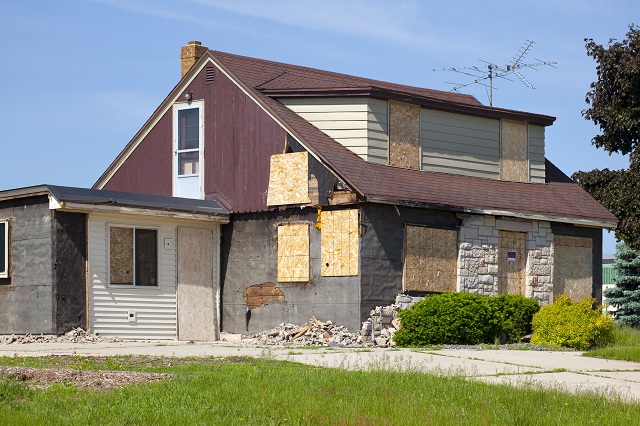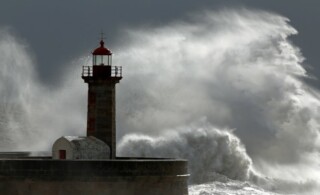
Like with any natural disaster, your first priority after an earthquake is to ensure your own safety and that of the people you love. Depending on the severity of the quake, you may need to venture outside of your immediate family to help friends, neighbors, and family members get out of harm’s way. But the work doesn’t end there.
Whether they send major shockwaves through an entire region or small seismic surges through one neighborhood, earthquakes are known for their destruction. From rearranging shelves and repairing broken belongings to cleaning up debris and dealing with major property damage, homeowners face the task of cleaning up the mess that is left behind.
Before you get overwhelmed, know that you don’t have to do it alone. After taking care of those around you, your first call should be to your insurance agent to discuss your coverage and plan your next steps. Then, you can use this guide to help you through the process of inspecting your home after an earthquake, as well as finding reputable contractors to help you assess the damage and make the necessary repairs.
Immediate Safety Hazards
Many people assume that unless an earthquake registers a magnitude of 4 or 5 on the Richter scale, the seismic activity won’t cause damage. Unfortunately, that’s just not true. Depending on your proximity to the epicenter of the quake, a lower-magnitude event may still cause considerable damage. Moreover, existing weaknesses in your home’s structure or systems — caused by age, disrepair, or previous seismic activity — could worsen after even a minor event. For that reason, you should always inspect your home for damage after any earthquake of any magnitude, starting with immediate safety hazards.
- Gas leaks: While you may feel a little silly, walking around your property and sniffing for the smell of gas is one of the first things you should do after the shaking stops. If you smell gas or see a busted gas line, turn off the main valve from the outside. Never use a lit match to check for gas leaks, as you could cause an explosion.
- Fire hazards: Check for exposed wiring and downed electrical lines. You should also clean up any and all flammable materials as quickly as possible, including spilled gasoline, cleaning products, and other hazardous materials.
- Structural damage: If any part of your home suffers significant structural damage, steer clear of that area. If you can, rope off the area and points of access to it in order to prevent additional damage or injury.
If any of these situations apply to you, leave the scene with any and all residents and guests. Inform neighbors of the danger if you can and call the authorities right away.
External Inspection
Once you know the scene is free of any immediate danger and your family is situated in a safe place, you can use the checklist below to complete a more thorough inspection of the exterior of your home. If you aren’t confident in your ability to determine whether your dwelling is safe to return to, you will probably want to hire a building inspector near your home to take over. Just be prepared to wait, because building inspectors are in high demand after any natural disaster.
Site
If you notice any of the following issues, contact a soil testing service near you. They can connect you with an engineer or geologist for a professional assessment and recommendation for repairs or rebuilding.
- Cracks in the ground
- Shifts in landscaping or structures at ground level
- Sinkholes or sand boils, where water appears to have boiled up through a layer of sand
- Slumping or bulging on the surface of the ground
- Falling rocks on slopes
- Any evidence of broken underground utility lines or septic tank ruptures or surfacing
Home Exterior
The following problems with your home’s exterior could indicate problems with its structural integrity. You should enlist the expertise of a local structural engineer to analyze and correct them to ensure your home is safe for you and your family.
- Total or partial building collapse
- Leaning structure
- Cracking or shifting out of square at doors, windows, or corners
- Bulging of structure
- Cracks in walls, stucco, or masonry
Foundation
Foundational issues range from relatively minor and inexpensive to fix to major issues that cost $10,000 or more to repair. Call a foundation repair specialist near you to determine the condition of your foundation if you notice the following issues:
- Fresh cracks
- Movement between slab and footing
Fireplace & Chimney
If your home has a fireplace or chimney, you’ll need to check it out as well. Start by contacting a nearby chimney and fireplace cleaning service, because they usually also offer safety inspections. If the damage is structural, they can refer you to an engineer.
- Total or partial chimney collapse
- Tilting or separation
- Exposed mortar
- Mortar deterioration
- Structure rocks back and forth when force is applied
Roof
This is one inspection you may want to leave to the experts, especially if you suspect damage. Call a local roof inspector to come and take a look. If they find any issues while they are there, hire a roofing company in your area to temporarily patch the roof or place a tarp to protect your belongings until you can schedule a repair and clear it with your insurance.
- Roof tiles that have shifted or detached
- Damage from limbs, chimneys, or other debris
- Damage to rooftop vents, fans, solar panels, or HVAC equipment
- Sagging ridges
- Tearing or movement at intersections between the roof and other parts of the structure
- Leaks
Interior Assessment
As long as it is safe to enter your dwelling, your next step will be to complete a thorough inspection of your home’s interior, looking for the issues detailed in the list below. Again, don’t hesitate to contact an earthquake recovery pro with the training and expertise to identify potentially hazardous situations.
Walls
- Cracks or buckling
- Detachment at corners of doors and windows
- Leaning
- Separation of the wall and floor
- Doors and windows that stick
Ceilings and Floors
When you’re inspecting your home after an earthquake, don’t forget to look up and down. Even minor ceiling or floor damage can be a cause for concern, because it may indicate more serious issues with hidden utility lines or a compromised roof. If you aren’t sure what you’re looking at, reach out to a general contractor near you with knowledge about your whole home’s structure.
- Cracking at joints and junctures
- Popped nails
- Separation from walls
- Water damage or leaking
- Sloping or sagging
- Holes or gaps
Appliances and Utilities
Just because your appliances and utilities look OK from the outside doesn’t mean they aren’t damaged. With so many moving parts, it’s important to test your appliances after an earthquake. Just make sure to wait until you are certain there is no gas leak or electrical malfunction, as discussed above.
- External damage
- Disconnection from tanks, hoses, or water lines
- Leaking of refrigerant, water, or other liquids
- Exposed wiring or damaged cords
Making Home Repairs
Once you’ve inspected your home, your insurance company and the local emergency management office will help you as you pursue payment for and completion of home repairs. While you may be tempted to do some of the work yourself, most earthquake damage is not DIY-friendly. Structural problems, roof repairs, and utility work is dangerous and requires the expertise and experience of a professional who is equipped to handle the inherent dangers of the job and who will complete the work up to standard. Otherwise, you would be putting your own health and safety at risk.
As you make repairs, you may also want to consider some “earthquake-proof” upgrades, like reinforcing your walls and bolting your house to its foundation. These projects can help protect your home — and everything in it — when there is another earthquake. You can hire a seismic retrofitter to inspect your property, make suggestions, provide a quote, and do the work.
After an earthquake, it can take days, weeks, or months to get your home back into tip-top shape. While waiting will be stressful, it’s important to take your time and do the job right, preferably incorporating some new and improved earthquake-proof features. Then, when you’re finally able to rest, you can do so knowing that your home and family are safer than they were before the natural disaster hit.
 Snow Removal Requests Significantly Increase After Juno Blizzard of 2015
Snow Removal Requests Significantly Increase After Juno Blizzard of 2015  The Ultimate Guide to Wildfire Safety
The Ultimate Guide to Wildfire Safety  The 20 Deadliest Tornadoes on Record in the US & World
The 20 Deadliest Tornadoes on Record in the US & World  Hurricanes vs Tornadoes vs Cyclones – What’s the Difference?
Hurricanes vs Tornadoes vs Cyclones – What’s the Difference?  Water, Water Everywhere: How to Prevent Flood Damage
Water, Water Everywhere: How to Prevent Flood Damage 

Are You Familiar With This Topic? Share Your Experience.